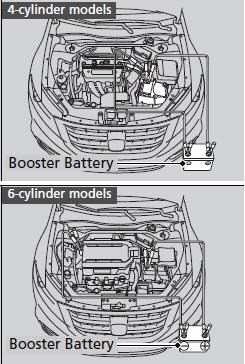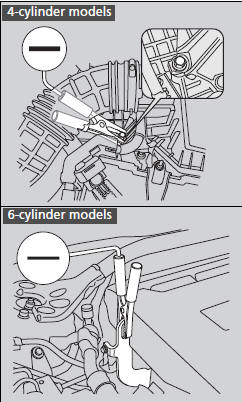Jump Starting
■Jump Starting Procedure
Turn off the power to electric devices, such as audio and lights. Turn off the engine, then open the hood.

1. Connect the first jumper cable to your
vehicle’s battery  terminal.
terminal.
2. Connect the other end of the first jumper
cable to the booster battery  terminal.
terminal.
- Use a 12-volt booster battery only.
3. Connect the second jumper cable to the
booster battery  terminal.
terminal.
WARNING
A battery can explode if you do not follow the correct procedure, seriously injuring anyone nearby.
Keep all sparks, open flames, and smoking materials away from the battery.
Securely attach the jumper cables clips so that they do not come off when the engine vibrates. Also be careful not to tangle the jumper cables or allow the cable ends to touch each other while attaching or detaching the jumper cables.

4. Connect the other end of the second jumper cable to the engine mounting bolt (4-cylinder models)/engine hanger (6-cylinder models) as shown.
Do not connect this jumper cable to any
other part.
5. If your vehicle is connected to another
vehicle, start the assisting vehicle’s engine
and increase its rpm slightly.
6. Attempt to start your vehicle’s engine. If it
turns over slowly, check that the jumper
cables have good metal-to-metal contact.
Battery performance degrades in cold conditions and may prevent the engine from starting.
■What to Do After the Engine Starts
Once your vehicle’s engine has started, remove the jumper cables in the following order.
1. Disconnect the jumper cable from your vehicle’s ground.
2. Disconnect the other end of the jumper cable from the booster battery
 terminal.
terminal.
3. Disconnect the jumper cable from your vehicle’s battery
 terminal.
terminal.
4. Disconnect the other end of the jumper cable from the booster battery
 terminal.
terminal.
Have your vehicle inspected by a nearby service station or a dealer.
See also:
Automatic Transmission
Shift to and depress the brake pedal
when starting the engine.
Shifting
Park
Turn off or start the engine. Transmission is locked.
Reverse
Neutral
Transmission is not locked.
Drive
N ...
Wipers and Washers
Wiper/Washer Control Lever
...
Safety of Infants and Small Children
Protecting Infants
An infant must be properly restrained in a rear-facing, reclining child seat
until the infant reaches the seat maker's weight or height limit for the seat, and
the infant is ...






